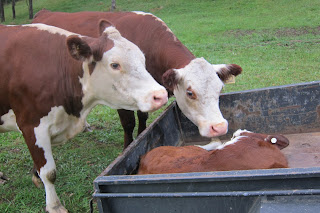Ever wondered how that pristine white garlic in the supermarkets gets to be so clean! It's grown in the soil so shouldn't it have a hint of it's growing environment on it? And the taste - well, there isn't any, it doesn't matter how many cloves go into the pot it is just so bland. To get it looking snowy white it's bleached and given a chemical bath - then you eat it! some extra reading -- http://www.naturalnews.com/022801_garlic_Australia_food.html
 |
| April planting |
 |
| up and growing |
 |
| October - not ready yet |
By May they were all up, then they just seemed to stop. Anxious to make sure my crop was not a complete failure I dug up a clove every month or so and I can report that all the growing action goes on below ground during winter. Each little clove slowly forms into a small new bulb that grows and grows till Spring. Then the green shoots really take off and the underground work gets serious as the little cloves morph into seriously big new bulbs.
 |
| My garlic is definitely not white |
This year after a very wet start we ended up with virtually no rain from July till harvest, so the crop had to be watered. The blindingly obvious became clear - water is essential. The bulbs at the edges of the watering system did not prosper nearly as well as those with plenty of water. Weeds were not a big issue because most of the growing cycle is in the colder months. I did discover a great Japanese tool for weeding that's more like a old cut throat razor than a hoe, it's so sharp you could shave with it- well I wouldn't, but that's how sharp it is. The tool comes with its own pouch, sharpener and a bottle of Camellia oil to clean it after use. Only the Japanese would treat a garden tool with such respect. Unfortunately mine has assimilated into the Aussie way of life a little too easily, it's slouching around in the shed looking pretty dirty.
You know it's time to dig up the bulbs when the green foliage starts to turn yellow and die off. Everything this year has been done by hand, so it's labour intensive. You just have to get down and dirty. Next year I will have to move into the 21st century and find some sort of machinary to help me.
 The crop was generally a success, except for the Giant Russians that are puny whimps. I don't know what went wrong.
The crop was generally a success, except for the Giant Russians that are puny whimps. I don't know what went wrong. On a sunny day the aroma of gently drying garlic drifting from the shed is tantalising. I can report that it's a successful vampire deterrent - while we see many kangaroos, wombats, foxes, rabbits and wallabies -- not a single vampire has been spotted lurking around the shed.
 |
| Garlic bulbils- I should have cut them off, but they looked too good! |




























